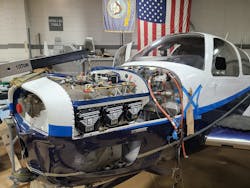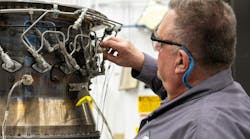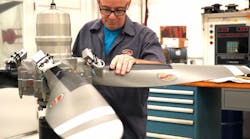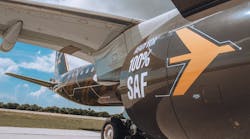Aircraft engine maintenance, like most things in 2022, is not as straightforward as it used to be. The strain on the supply chain and customer trends are changing the way maintenance is being planned for and performed.
JD Kuti, vice president of Pinnacle Aircraft Engines, has been working on engines for over 14 years. He says things have definitely changed over the course of the past few years.
Securing parts is becoming the greatest challenge of the job.
“It has changed,” Kuti said. “Two years ago, beginning of COVID, the supply chain wasn't that bad yet. We were still able to get parts and move through everything. Over probably, I would say, the last year it's gotten worse. And the last six months has gotten even worse. It's kind of been gradually downhill.”
Located in Silverhill, Alabama, and founded in 2010, Kuti and his partners bought Pinnacle in 2019. They specialize in Lycoming and Continentals, with Kuti saying there isn’t anything they don’t work on besides “some of the older” engines.
“It's not that we can't do them or won't do them, it's the parts are hard to get for them – makes it very difficult to do them,” he explained.
The work Pinnacle does runs the gamut from major overhauls to prop strikes and cam changes. But Kuti said the majority of the work they see is engine overhauls.
“We're taking the engine. We tear them down, re-certify the crank in the case, overhaul the rocker arms, rods, inspection of all the steel components in the engine, inspection of all the aluminum components. We always put new cylinders on, new pistons, overhaul the fuel system, mags, new harness, new spark plugs, and we build everything within new tolerances. Some other places may do it within service limits. The factory gives us service limits and they also give us new limits. And here at Pinnacle we do everything within new limits,” he said.
Kuti reminisced that the most unusual repair they’ve ever seen was cleaning concrete mix out of a sabotaged engine.
“Needless say it made a mess,” he laughed.
Located nearly 1,000 miles away in Waukesha, WI, Samuel Cryer, president of Plane Safe Aircraft Maintenance, may never have seen an engine full of concrete, but is otherwise experiencing similar issues as Kuti.
“Yeah, parts are a task. We're still able to get stuff and find stuff,” Cryer said, adding that given they're near Aircraft Spruce Chicago, securing parts has not been as difficult. “[It’s] great for us, because we don't have to keep a lot of things in stock. We basically use them as our stock room.”
Cryer, a mechanic since 1989, started Plane Safe in 2022 and is celebrating their 20th anniversary. They work on GA aircraft, corporate jets and “everything in between,” said Cryer.
“We do inspections, repairs, and everything you can think of on an airplane,” he continued.
For engines, Plane Safe works on both Continental and Lycoming, all variations, with single engine piston being the most common. They also maintain Rotax engines and some turbines.
“We have PT6s and a couple of Williams engines that we maintain, along with some Garretts. But I would say, the bulk of our business is going to be the piston segment,” Cryer said.
Cryer said that their approach to repairs is to treat everything as an uncommon repair, no matter how common it may be.
“When somebody says it's a common repair, that means that you can do it with your eyes closed. We don't want to do that. We have a couple of guys working on a single problem, just to make sure we don't miss anything,” Cryer explained, adding that the benefit of two sets of eyes on one problem is that it ensures different approaches.
Where one person may see a problem as easily routine, Cryer continued, “Another guy can look at it and say, ‘Hey, you might want to try this because it's not as common as you think.’”
The Parts Problem
What’s become the most common problems each is facing is parts and wrestling with an increasingly strained supply chain.
For Kuti, cylinders have become more and more difficult to secure.
“There's a lot of problems with supply chain. Mainly, the biggest thing right now is cylinders. Getting cylinders for some of these engines is very difficult, especially if you kind of have an oddball engine that makes it even harder. Because the manufacturers aren't changing over tooling to build cylinders for an engine that there's just not a lot of them out there,” he said.
The scarcity is not limited to cylinders, however.
“I think it's really across the market, everybody is seeing it, even oil filters and spark plugs are difficult to get, for us and also for maintenance facilities as well, to be able to complete some of the tasks that need to be done,” Kuti continued.
It’s oil filters that Cryer is having the toughest time with finding.
“The biggest thing right now we see, as far as what's hard to get, are oil filters. You can't get a Champion oil filter. They're hard to get. And if you can get them, you can get one or two at a time,” Cryer said. “We've always used Champions. But now, just because we can't get Champions, we're putting Tempest on as well. So, whatever we can get oil filters, we're just buying them and getting them, so we have them.”
Tires may be the next hard to find item, Cryer said he’s heard, so they’ve been stocking up on those while they’re still available, should that prediction come true.
Stocking up on what can be found is, so far, the best solution to overcoming the problem, with hunting for parts becoming almost a full-time job by itself.
“We try to order as much stuff as we can, as soon as we know the engine's coming, and try to get stocked up. We buy stock as much as we can,” Kuti said.
“We have to hunt pretty much every day for parts,” he continued. “If I have an engine in here that I know cylinders are hard to get, we're looking every single day, because sometimes a larger distributor may get the cylinders in and not have them sold yet. So, they'll actually put them up for sale, and if you don't check every day, they're gone. They sell super fast. So, it's really just staying on top of it. Every single day, hunting for what you need, and just hoping that sooner or later, somebody will end up with some. Even if you only get half of what you need, you're halfway there at least.”
Cryer too is often on the hunt for parts. He says that those in the aviation community are supporting each other where they can.
“For supply chain stuff, for us, we have so many avenues we can use to get parts. And we're not afraid to search, we're not afraid to call people, we're not afraid to call other shops and ask for their help on it. And we do that because we're all still a community.
"If somebody calls me, I really don't want to sell over the counter parts. I want to keep them for my customers. But if there's a shop in a pinch, we help them out. And we get the same thing from other shops in the area,” he said.
Places that historically would not sell parts over the counter, Cryer said are now making exceptions for shops in need or helping them locate the part when they don’t have it.
“I think that, with all the resources out there, and we're a pretty big country, and people have stuff on their shelves in places, so we end up being able to find stuff. Not easy, but we find it and we can get it here,” Cryer said.
Compounding Factors
While numerous factors are driving the parts shortage and overall supply chain strain, one of the factors driving the hunt for parts is simply that it’s an issue affecting everyone, creating quasi-competition between all. As Kuti explains, smaller shops can sometimes be left behind.
“The biggest problem we run into is a lot of the large suppliers, they're ordering such large quantities, that when a smaller shop like us puts an order in with a distributor or the manufacturer, we're kind of on the back end of that list,” Kuti said.
Kuti continued that because the big distributors are putting in a $100,000 worth of orders each month to keep up with their and their customers needs, it creates a backlog for shops like Pinnacle whose parts needs are different.
“It's hard for a smaller shop like us to do that, especially when we may not need that many cylinders of one model, we may need 10 different models worth of cylinders,” Kuti explained.
Another factor can be the literal supply chain itself, with ordered parts taking longer than usual to arrive.
“The toughest thing that we have, is not even a parts procurement right now, as much as it is the freight companies. They are just way behind the curve,” said Cryer.
Cryer said in one instance an engine was lost for some time in transit to them.
“We had a PT6 engine shipped to us and lost, if you can imagine that. It was absolutely crazy. It was missing, realistically, for a little over three weeks. And it came from Canada, so it was somewhere stuck in quarantine with all that stuff that goes on,” he said. “More than trying to get stuff, it has been trying to get stuff from the freight companies.”
The age of engine is also determining parts availability. Kuti said there is a larger discrepancy between finding parts for newer engines compared to older ones.
“For instance, last year, Continental kind of changed directions and they pulled a lot of part numbers off their production list. So a lot of the older engines, C85s O300s, the E model engines, E225s and stuff like that, a lot of the parts were pulled off of production list. And if there's not a PMA part for that engine, you're kind of looking for a hen's tooth. You're actually calling just trying to find anybody that has some old surplus of those components,” he said.
The PMA companies have stepped up and started producing a lot of these components, but even still there's just certain things that can't be found anymore unless you have old stock of it, Kuti said. He sees a time when these engines will need to be replaced with new models due to unavailable parts.
“But once all that old stock that people have is depleted, you're really going to be left with trying to figure out the next move. And I think a lot of it's going to be changing to a newer style engine. Most of the aircraft that have those older style engines already have STCs to go to a different engine model,” he said.
Future Outlook
All of this issue with parts and the supply chain comes at a time when business is on an uptick, with Cryer describing them as being “almost chaotic busy.”
“Our world here at Plane Safe has been absolutely busy. We are chaotic busy, almost. Our normal customer's based here in Waukesha. We actually bring customers from all over the place. But we've seen, just in this year alone, a pretty good influx of new customers coming into us. I'm not sure why that is,” he said.
And customers are learning to adapt to the changing landscape. Kuti says people are starting to plan ahead more and it’s advice he’s recommending people follow.
“If you know you're coming up to where you need to do an overhaul, or you want to do an overhaul, get with what engine shop you want and prefer to use. At least get an agreement in place and maybe even a deposit on getting cylinders on order,” Kuti said.
Kuti said they’re doing that quite a bit with customers, as it speeds up the process.
“We'll pre-order cylinders with a deposit, get those on the shelf and let the customer know, ‘Hey, we're ready for you when you are.’ And that way it speeds up the process,” he said.
Customers are also shifting to opt for repairs rather than overhauls.
“If their engine comes in for repair, they'll stick to staying a repair just because when they find out how long it may take to get cylinders, it kind of scares them off,” he said.
Cryer said that their uptick in business is shining a light on another issue, finding mechanics to take on the increased workload.
“I think in our industry right now, the biggest thing is trying to find mechanics. That's probably the single biggest thing that we have right now,” he said.
Cryer’s other concern is fuel prices and hoping that they’ll stabilize soon, or else he fears people may no longer find flying cost-effective.
“I don't really have a good finger on that pulse yet, because everybody is still flying and they're still spending money on their airplanes. I don't think the economy's caught up with them yet. You know as well as I do, a lot of these airplane owners, if they can afford an airplane, they can afford to go fly them.
“But some of these guys, to a certain point, they're going to say, ‘You know what? This becomes not cost-effective for me to go and have fun. I can go have fun playing golf for cheaper than I can go fly my airplane around.’ That's a little bit of a concern for me. I think short term, if we don't get the fuel prices under control, we might see a decline in flying,” Cryer said.
So far, it hasn’t been the case. Cryer reports that over the past seven or eight years, the average flying time of an airplane they were having come in for an annual inspection was around 15 to 20 hours at the most. But last year and this year, they’ve seen people flying closer to 35 and 40 hours since their last inspection.
Patience, Cryer said, is the key to weathering the issues the industry faces right now.
“I think patience is number one, especially the way it is now. It is like any other industry, everybody has their challenges. And we know, as pilots and as mechanics, that whatever gets thrown at us, we're a pretty smart bunch, I think, and we can figure out how to make it through it all. I don't think we're going to suffer too much. We just have to know that there's going to be that light at the end of the tunnel, if it darkens in on us,” Cryer said.
For Kuti, he doesn’t see a real end in sight for the demand and supply chain to get caught back up to each other anytime soon.
“I'm hoping it gets resolved soon. I have spoken with Superior Air Parts and Lycoming, both of them are doing all they can to get more production done. They've opened up some extra shifts. Every time I talk to them, they're getting back in the groove and able to start getting stuff done.
“The good news is the vendors and the manufacturers are talking to us and saying, ‘Hey, we're getting this figured out. We're doing all we can.’ Superior just opened up a third shift, I believe they're running shift work, trying to produce as much as they possibly can,” Kuti said.
In the meantime, Kuti’s advice is to do the same as his customers are doing: plan ahead.
“Order some oil filters, have some on the shelf, have some spark plugs, oil, all your general maintenance stuff, make sure you have it. It's getting where you go in for an oil change and you can't get a filter, it's really hard to change your oil. So definitely kind of stock up on the necessities, put a couple on the shelf. If you know you change your oil three times a year, have three oil filters. When you get down to that last one, go ahead and order two more, and that way you have them,” he said.





